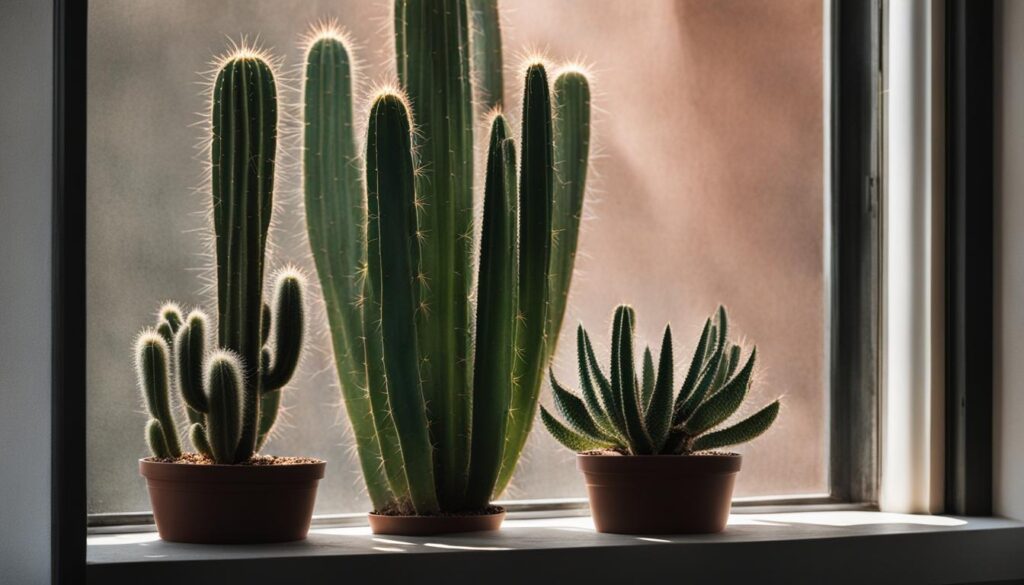Etiolation is a phenomenon that occurs when a cactus does not receive enough light. This can be a common issue for desert cacti that are grown as houseplants, as the lower intensity of sunlight indoors can lead to light deficiency and hinder their growth. When a cactus lacks sufficient light, its stem will grow faster than normal, but it will become thinner and pointed at the tip instead of rounded. The stem may also become paler in color, and the spines may be more widely spaced or shorter. In some cases, the pads of prickly pear cacti can become elongated and tubular instead of flat and round.
Key Takeaways:
- Etiolation occurs when a cactus lacks sufficient light, leading to abnormal growth.
- Signs of etiolation include thin and pointed stems, pale coloration, and irregular spines.
- Light deficiency in cacti can be caused by a lack of sunlight, absence of winter dormancy, or poor light exposure.
- Preventing etiolation involves providing adequate sunlight, allowing for winter dormancy, adjusting cactus placement, and pruning affected stems.
- Once a cactus has experienced etiolation, the affected stem will not regain its normal shape, but pruning can help promote new growth.
Signs and Symptoms of Etiolation in Cacti
Etiolation in cacti manifests itself in various signs and symptoms, indicating a deficiency in light. Recognizing these indications is crucial for addressing the issue promptly and preventing further etiolation. Common indicators include:
- Thin and pointed stems: Etiolated cacti display elongated and slender stems, which are a result of rapid growth due to insufficient light.
- Pale coloration: Cacti lacking adequate light develop pale stems, losing the vibrant green hue typically associated with healthy plants.
- Spines that are more widely spaced or shorter: The spacing and length of spines on etiolated cacti may be distorted, further highlighting the effects of light deficiency.
- Stunted growth: Etiolation hinders the overall growth of cacti, leading to diminished size and vigor when compared to healthy specimens.
It is essential to monitor cacti closely for these signs of etiolation to initiate appropriate measures and restore optimal light conditions. Addressing the underlying light deficiency promptly can help prevent further etiolation and promote healthy growth.
Quote:
“The signs of etiolation in cacti are evident through their thin and pointed stems, pale coloration, spaced spines, and stunted growth. Observing these symptoms allows the gardener to take corrective action and prevent further etiolation.” – [Source Name]
| Signs of Etiolation | Symptoms |
|---|---|
| Thin and pointed stems | Elongated and slender growth |
| Pale coloration | Loss of vibrant green hue |
| Spines that are more widely spaced or shorter | Distorted spine arrangement |
| Stunted growth | Diminished size and vigor |
Causes of Etiolation in Cacti
Etiolation in cacti can be attributed to several factors, all of which revolve around the lack of proper sunlight and light exposure. These factors include:
- Lack of sunlight: Cacti require a significant amount of sunlight to thrive, as they are adapted to desert environments with high sun exposure. When grown indoors, cacti may not receive the same intensity of light as they would outdoors, leading to etiolation.
- Indoor growing conditions: Indoor cacti are often subjected to poor light exposure due to their positioning within the house. Placing cacti in areas with limited natural light, such as far corners or shaded spots, can contribute to etiolation.
- Winter dormancy: Cacti typically experience a period of winter dormancy where growth slows down or stops completely. During this time, the days are shorter and sunlight is limited. However, cacti that are kept actively growing throughout the winter months may suffer from etiolation due to the reduced light levels.
- Phototropism: Cacti exhibit a natural behavior called phototropism, where they grow towards a light source. If a cactus is not positioned in a way that allows it to receive sufficient light from all directions, it may stretch towards the available light, resulting in etiolation.
Understanding these causes of etiolation is crucial in providing the necessary care and light exposure to prevent the condition and promote healthy cactus growth.
Preventing and Treating Etiolation in Cacti

Proper care and attention are essential for preventing and treating etiolation in cacti. By providing adequate sunlight, allowing for winter dormancy, adjusting placement, and pruning affected stems, you can promote healthy growth and prevent further etiolation.
1. Providing Adequate Sunlight
Cacti, especially desert varieties, thrive in direct sunlight. When grown indoors, it is crucial to ensure they receive sufficient light. Placing them in a southern exposure, such as near a sunny window, can provide the necessary light intensity. This will help prevent etiolation and promote balanced growth.
2. Allowing Winter Dormancy
Many cacti naturally go into a period of dormancy during the winter months, simulating their natural habitat in the desert. During this time, the days are shorter, and sunlight is limited. Allowing your cactus to rest and conserve energy during the low light months can help prevent etiolation. Reduce watering and avoid fertilizing during this period.
3. Adjusting Placement
The placement of your cactus plays a significant role in ensuring optimal light exposure. Regularly assess the location of your cactus and make adjustments as needed. Avoid placing it in areas where it does not receive enough natural light, such as dark corners or rooms with minimal windows. By finding the right spot, you can help your cactus receive the light it needs to thrive.
4. Pruning Etiolated Stems
If your cactus has already experienced etiolation, pruning affected stems can help promote new growth and improve its overall appearance. Carefully cut off the etiolated stems below the damaged sections, encouraging the plant to produce healthier, more rounded stems in response to increased light exposure. Remember to use clean, sharp tools to avoid unnecessary damage to the plant.
“Proper care and attention are essential for preventing and treating etiolation in cacti.”
By following these cactus care tips, you can prevent etiolation and ensure your cacti remain healthy and vibrant. Providing adequate sunlight, allowing for winter dormancy, adjusting placement, and pruning when necessary are all important strategies for maintaining the optimal growth and appearance of your cacti.
| Tips for Preventing and Treating Etiolation in Cacti |
|---|
| Provide adequate sunlight by placing cacti in a southern exposure. |
| Allow cacti to go into a winter dormancy period. |
| Regularly adjust the placement of cacti to ensure optimal light exposure. |
| Prune etiolated stems to promote new growth. |
By implementing these cactus care tips into your routine, you can enjoy healthy, vibrant cacti that thrive in their environment.
Dealing with Etiolated Cactus Stems
Once a cactus has experienced etiolation, the affected stem will not regain its normal shape. However, there are steps you can take to address the issue and promote new growth. One option is to prune the etiolated stems, cutting them off below the damaged section.
This can encourage the plant to produce new stems that will grow in more intense light and have a more normal shape. By removing the etiolated parts, you are allowing the cactus to redirect its energy towards healthy growth, ensuring a more balanced and aesthetically pleasing appearance.
Alternatively, you can choose to embrace the cactus’s distorted shape and appreciate its unique characteristics. Etiolation may give the cactus a whimsical and unconventional appeal, adding a touch of personality to your plant collection.
However, regardless of whether you choose to prune or embrace the distorted shape, it is crucial to provide the cactus with the proper care and light exposure moving forward to prevent further etiolation. Giving your cactus bright, indirect sunlight and ensuring it receives the recommended amount of light for its specific species will promote healthy growth and help maintain its natural shape.
FAQ
What is etiolation?
Etiolation is a phenomenon that occurs when a cactus does not receive enough light. It leads to the cactus stems growing faster than normal, becoming thinner and pointed, and appearing paler in color.
What are the signs and symptoms of etiolation in cacti?
The signs of etiolation in cacti include thin and pointed stems, pale coloration, and spines that are more widely spaced or shorter than usual. The growth of the cactus may also be stunted compared to healthy plants.
What causes etiolation in cacti?
Etiolation in cacti is primarily caused by a lack of sunlight, especially for cacti grown indoors. Other factors include the absence of a winter dormancy period and poor light exposure due to incorrect positioning of the cactus.
How can I prevent and treat etiolation in cacti?
To prevent etiolation, provide cacti with adequate sunlight by placing them in a southern exposure. Allowing them to go into a winter dormancy period can also help. To treat etiolation, prune the affected stems or adjust the cactus’s placement to encourage new growth.
How do I deal with etiolated cactus stems?
Etiolated cactus stems cannot regain their normal shape. However, you can prune the etiolated stems to encourage new growth in more intense light or embrace the cactus’s unique shape. It is important to provide proper care and light exposure moving forward to prevent further etiolation.

